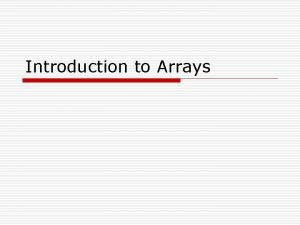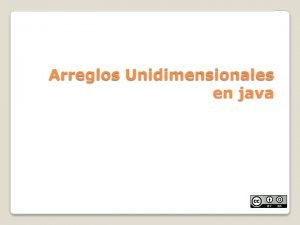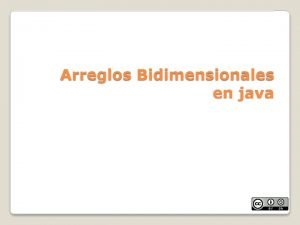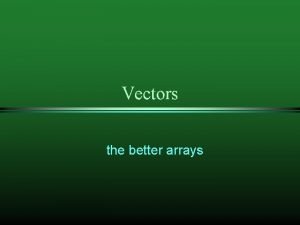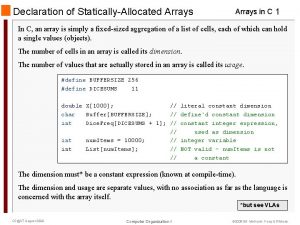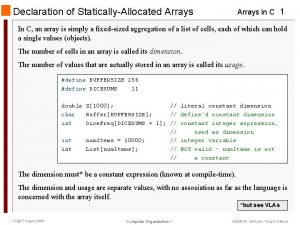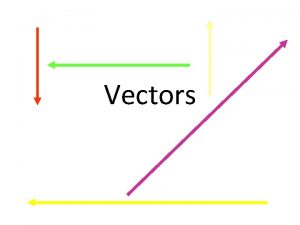StaticallyAllocated Arrays C Arrays and Vectors 1 In












- Slides: 12

Statically-Allocated Arrays C++ Arrays and Vectors 1 In C++, an array is simply a fixed-sized aggregation of a list of cells, each of which can hold a single value (object), all of which must be of the same type. The number of cells in an array is called its dimension. The number of values that are actually stored in an array is called its usage. const int BUFFERSIZE = 256; const int DICESUMS = 11; char int Buffer[BUFFERSIZE]; // constant integer dimension Dice. Freq[DICESUMS + 1]; // constant integer expression, // used as dimension int num. Items = 10000; // integer variable string Inventory[num. Items]; // NOT valid - num. Items is not // a constant The dimension MUST be a constant value (known at compile-time). The dimension and usage are separate values, with no association as far as the language is concerned with the array itself. Computer Science Dept Va Tech January 2008 Data Structures & OO Development I © 2006 -08 Mc. Quain & Barnette

Limitations C++ Arrays and Vectors 2 There is no way to alter the dimension of an array once it is declared. Access to individual cells uses the same syntax as Java; however, there is no run-time check to be sure that the specified index is actually valid. There is no automatic aggregate operations for arrays in C++. - operator=() does not copy the contents one array into another - arrays cannot be passed by value to a function - operator==() is not supported for arrays When an array is passed to a function, its dimension and/or usage must generally be passed as well. Computer Science Dept Va Tech January 2008 Data Structures & OO Development I © 2006 -08 Mc. Quain & Barnette

Out-of-Bounds Array Indices C++ Arrays and Vectors 3 What happens when a statement uses an array index that is out of bounds? First, there is no automatic checking of array index values at run-time (some languages do provide for this). Consider the C++ code: int A[7]; A[7] = 42; A[1] A[2] A[3] A[4] A[5] A[6] Memory A[0] Logically A[7] does not exist. Physically A[7] refers to the int-sized chunk of memory immediately after A[6]. The effect of the assignment statement will be to store the value 42 at that location: ? ? ? ? 42 Clearly this is undesirable. What actually happens as a result depends upon what this location is being used for… Computer Science Dept Va Tech January 2008 Data Structures & OO Development I © 2006 -08 Mc. Quain & Barnette

Memory Access Errors C++ Arrays and Vectors 4 Consider the possibilities. The memory location A[7] may: - store a variable declared in your program - store an instruction that is part of your program (unlikely on modern machines) - not be allocated for the use of your program In the first case, the error shown on the previous slide would cause the value of that variable to be altered. Since there is no statement that directly assigns a value to that variable, this effect seems very mysterious when debugging. In the second case, if the altered instruction is ever executed it will have been replaced by a nonsense instruction code. This will (if you are lucky) result in the system killing your program for attempting to execute an illegal instruction. In the third case, the result depends on the operating system you are using. Some operating systems, such as Windows 95/98/Me do not carefully monitor memory accesses and so your program may corrupt a value that actually belongs to another program (or even the operating system itself). Other operating systems, such as Windows NT/2000/XP or UNIX, will detect that a memory access violation has been attempted and suspend or kill your program. Computer Science Dept Va Tech January 2008 Data Structures & OO Development I © 2006 -08 Mc. Quain & Barnette

Moral C++ Arrays and Vectors 5 Intelligent, disciplined programmers make efficient, effective use of arrays in C++. Unintelligent and careless programmers find C++ arrays to be an effective means of producing unstable programs. Fortunately, there is an alternative… Computer Science Dept Va Tech January 2008 Data Structures & OO Development I © 2006 -08 Mc. Quain & Barnette

C++ vector Type C++ Arrays and Vectors 6 The C++ vector mimics the behavior of a dynamically allocated array and also supports automatic resizing at runtime. vector declarations: vector<int> i. Vector; vector<int> j. Vector(100); cin >> Size; vector<int> k. Vector(Size); vector element access: j. Vector[23] = 71; int temp = j. Vector[41]; cout << j. Vector. at(23) << endl; int j. Front = j. Vector. front(); int j. Back = j. Vector. back(); vector reporters: Computer Science Dept Va Tech January 2008 cout if ( << j. Vector. size(); << j. Vector. capacity(); << j. Vector. max_capacity(); !j. Vector. empty() ) //. . . Data Structures & OO Development I © 2006 -08 Mc. Quain & Barnette

vector Constructors C++ Arrays and Vectors 7 The vector template provides several constructors: vector<T> V; //empty vector<T> V(n, value); //vector with n copies of value vector<T> V(n); //vector with n copies of default for T The vector template also provides a suitable deep copy constructor and assignment overload. Computer Science Dept Va Tech January 2008 Data Structures & OO Development I © 2006 -08 Mc. Quain & Barnette

vector Example #include <iostream> #include <iomanip> #include <vector> using namespace std; int main() { C++ Arrays and Vectors 8 // for vector template definition Specify initial vector size. int Max. Count = 100; vector<int> i. Vector(Max. Count); for (int Count = 0; Count < Max. Count; Count++) { i. Vector[Count] = Count; Can access like an array… } } Warning: the capacity of this vector will NOT automatically increase as needed if access is performed using the [] operator. See the discussion of member functions insert() and put_back(). Computer Science Dept Va Tech January 2008 Data Structures & OO Development I © 2006 -08 Mc. Quain & Barnette

vector Indexing C++ Arrays and Vectors 9 In the simplest case, a vector object may be used as a simple dynamically allocated array: int Max. Count = 100; vector<int> i. Vector(Max. Count); for (int Count = 0; Count < 2*Max. Count; Count++) { cout << i. Vector[Count]; } However, the usage above provides neither runtime checking of the vector index bounds, or dynamic growth. If the loop counter exceeded the capacity of the vector object, an access violation would occur. int Max. Count = 100; vector<int> i. Vector(Max. Count); for (int Count = 0; Count < 2*Max. Count; Count++) { cout << i. Vector. at(Count); } Use of the at() member function causes an out_of_bounds exception in the same situation. Computer Science Dept Va Tech January 2008 Data Structures & OO Development I © 2006 -08 Mc. Quain & Barnette

STL Iterators C++ Arrays and Vectors 10 iterator an object that keeps track of a location within an associated STL container object, providing support for traversal (increment/decrement), dereferencing, and container bounds detection. (See Stroustrup 3. 8. 1 – 3. 8. 4) An iterator is declared with an association to a particular container type and its implementation is both dependent upon that type and of no particular importance to the user. Iterators are fundamental to many of the STL algorithms and are a necessary tool for making good use of the STL container library. Each STL container type includes member functions begin() and end() which effectively specify iterator values for the first element and the "first-past-last" element. Computer Science Dept Va Tech January 2008 Data Structures & OO Development I © 2006 -08 Mc. Quain & Barnette

vector Iterator Example C++ Arrays and Vectors 11 string Digit. String = "45658228458720501289"; vector<int> Big. Int; for (int i = 0; i < Digit. String. length(); i++) { Big. Int. push_back(Digit. String. at(i) - '0'); } Inserting with the push_back() member, Big. Int will grow to hold as many digits as necessary. vector<int> Copy; vector<int>: : iterator It = Big. Int. begin(); while ( It != Big. Int. end() ) { Copy. push_back(*It); It++; } Dereference iterator to access its target Advance iterator to next element. Computer Science Dept Va Tech January 2008 Obtain reference to target of iterator. This could also be written using a for loop, or by using the assignment operator. Data Structures & OO Development I © 2006 -08 Mc. Quain & Barnette

Iterator Operations C++ Arrays and Vectors 12 Each STL iterator provides certain facilities via a standard interface: string Digit. String = "45658228458720501289"; vector<int> Big. Int; for (int i = 0; i < Digit. String. length(); i++) { Big. Int. push_back(Digit. String. at(i) - '0'); } vector<int>: : iterator It; Create an iterator for vector<int> objects. It = Big. Int. begin(); int First. Element = *It; Target the first element of Big. Int and copy it. It++; Step to the second element of Big. Int. It = Big. Int. end(); Now It targets a non-element of Big. Int. Dereference will yield a garbage value. It--; int Last. Element = *It; Back It up to the last element of Big. Int. Computer Science Dept Va Tech January 2008 Data Structures & OO Development I © 2006 -08 Mc. Quain & Barnette
 Are vectors dynamic arrays
Are vectors dynamic arrays Dynamic arrays and amortized analysis
Dynamic arrays and amortized analysis Searching and sorting arrays in c++
Searching and sorting arrays in c++ What are the advantages of arrays?
What are the advantages of arrays? The multimodal text big ed mona
The multimodal text big ed mona Parallel array java
Parallel array java Array of arrays c++
Array of arrays c++ Parallel arrays
Parallel arrays Partially filled arrays
Partially filled arrays C++ parallel arrays
C++ parallel arrays Why do we need arrays?
Why do we need arrays? Arreglo java
Arreglo java Arreglos bidimensionales en java
Arreglos bidimensionales en java







